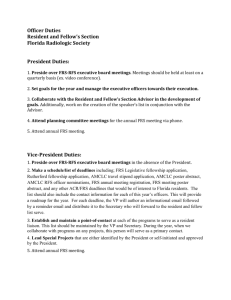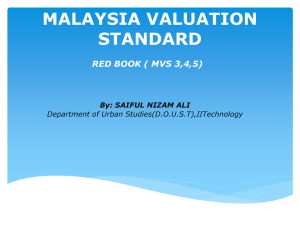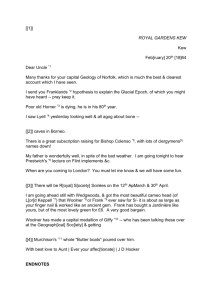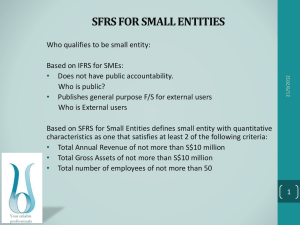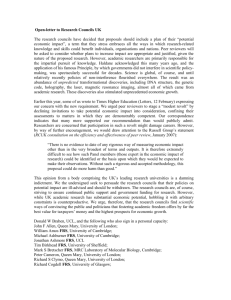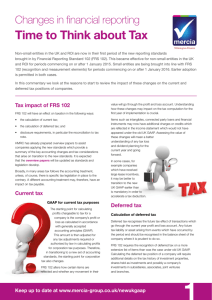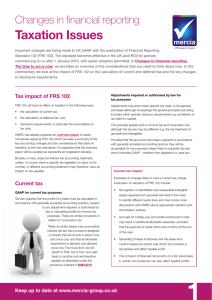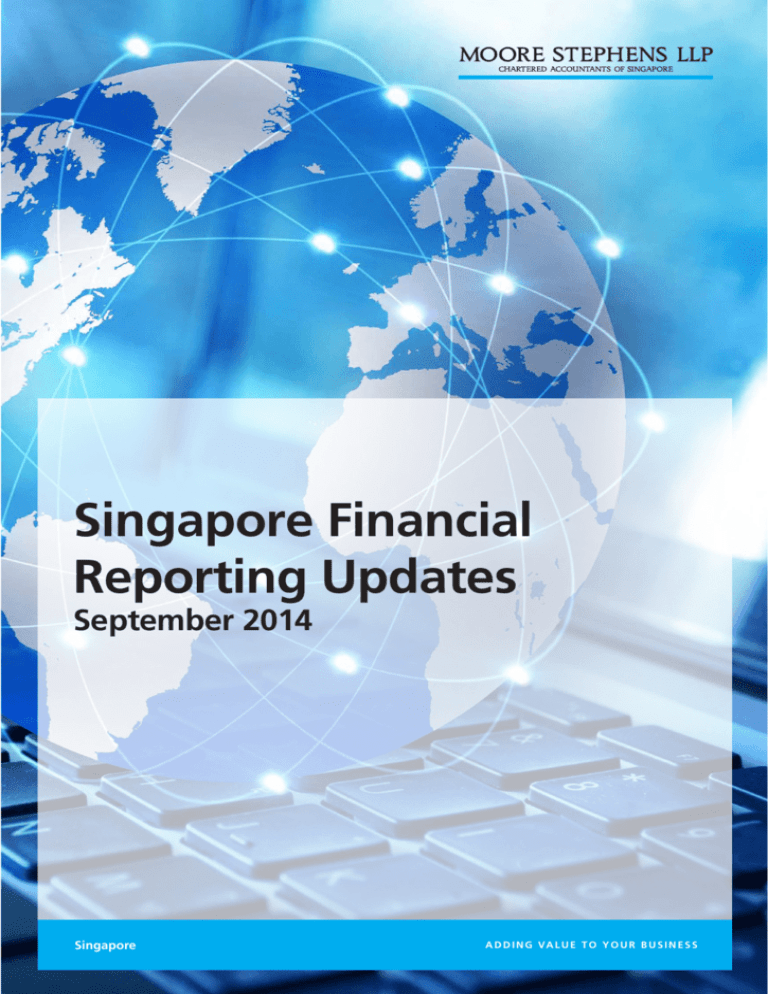
Singapore Financial
Reporting Updates
September 2014
Singapore
A D D I N G VA L U E T O Y O U R B U S I N E S S
Singapore Financial Reporting
Updates
September 2014
Table of contents
Introduction ............................................................................................................................................ 1
Section A: Amended FRSs ...................................................................................................................... 2
A1
Amendments to FRS 19 Employee Benefits- Defined Benefit Plans: Employee Contributions ... 3
A2
FRS 114 Regulatory Deferral Accounts ....................................................................................... 4
A3
Improvements to FRSs ................................................................................................................ 5
Improvements to FRSs (January 2014) ................................................................................................... 6
Improvements to FRSs (February 2014) ................................................................................................. 9
Section B: Global Financial Reporting Developments......................................................................... 10
B1
IFRSs not yet adopted in Singapore .......................................................................................... 11
Introduction
The Singapore and global financial reporting landscape is facing a new wave of fundamental and
upcoming changes. Among these, the most significant are likely to be the changes in the accounting
models for consolidation and joint arrangements, which takes effect in Singapore this year; revenue,
which will likely take effect in 2017; and financial instruments, which will likely take effect in 2018.
A significant number of standards, interpretations and amendments will take effect for annual
periods beginning on or after 1 January 2014, which are listed below. However, the salient features
of these standards, interpretations, and amendments have already been included in two of our
previous publications, Singapore Financial Reporting Updates September 2012, and Singapore
Financial Reporting Updates October 2013. Accordingly, this publication will not delve further into
these pronouncements.
•
•
•
•
•
•
•
•
•
•
•
•
•
FRS 27 (revised 2011) Separate Financial Statements
FRS 28 (revised 2011) Investments in Associates and Joint Ventures
FRS 110 Consolidated Financial Statements
FRS 111 Joint Arrangements
FRS 112 Disclosure of Interests in Other Entities
INT FRS 121 Levies
Amendments to FRS 32: Offsetting Financial Assets and Financial Liabilities
Amendments to FRS 36: Recoverable Amount Disclosures for Non-Financial Assets
Amendments to FRS 39: Novation of Derivatives and Continuation of Hedge Accounting
Amendments to FRS 110 Consolidated Financial Statements, FRS 111 Joint Arrangements
and FRS 112 Disclosure of Interests in Other Entities - Transition guidance
Amendments to FRS 110, FRS 112 and FRS 27: Investment Entities
Amendments to FRS 110, FRS 111, FRS 112, FRS 27 (2011) and FRS 28 (2011): Mandatory
Effective Date
Amendments to FRS 110, FRS 111 and FRS 112: Transition Guidance
Additionally, there are a number of amendments and improvements that are effective for annual
periods beginning on or after 1 July 2014, which will be discussed in Section A of this publication.
These are:
•
•
•
•
Amendments to FRS 19: Defined Benefit Plans: Employee Contributions
FRS 114 Regulatory Deferral Accounts
Improvements to FRSs (January 2014)
Improvements to FRSs (February 2014)
As at the date of writing, no further technical pronouncements have been issued by the Accounting
Standards Council (ASC). However, the Accounting Standards Council has announced on 29 May
2014 that Singapore-incorporated companies listed on the Singapore Exchange (SGX) will have to
apply a new financial reporting framework that will be identical to the International Financial
Reporting Standards (IFRS) in 2018. As such, listed companies cannot afford to ignore the following
financial reporting developments that are taking place. A quick summary of such developments is
provided in Section B of this publication.
We trust that you will find this publication an excellent resource in updating your understanding of
financial reporting developments, both in Singapore and globally. We strongly encourage you to
consult your regular Moore Stephens LLP contact should you have any questions or comments
regarding the developments highlighted in this publication. We remain committed to be your
valuable and trusted advisor.
Singapore Financial Reporting Updates – September 2014 | 1
Section A: Amended FRSs
Section A: Amended FRSs
A1
Amendments to FRS 19 Employee Benefits – Defined Benefit Plans:
Employee Contributions
A2
FRS 114 Regulatory Deferral Accounts
A3
Improvements to FRSs
2 | Singapore Financial Reporting Updates – September 2014
A1 Amendments to FRS 19 Employee Benefits- Defined Benefit
Plans: Employee Contributions
ASC issued Amendments to FRS 19: Defined Benefit Plans: Employee Contributions in January 2014.
Key Amendments
This amendment changes the accounting for contributions from employees or third parties that are
linked to service:
•
When the contribution amount is dependent on the number of years of service, those
contributions should be attributed to periods of service using the same attribution method
required by paragraph 70 of FRS 19 for the gross benefit, which involves either using the
plan’s contribution formula or on a straight-line basis.
•
When the contribution amount is independent of the number of years of service, the
attribution method in paragraph 70 of FRS 19 may also be used. However, an alternative
method for such contributions is to recognize them as a reduction in the service cost in the
period in which the related service is rendered. Examples of such contributions include those
that are fixed in amount throughout the service period, or where the contribution amounts
are a fixed percentage of salary.
For example, consider a simple contributory plan where a new joiner is entitled to a pension of 10%
of final salary for each year of service. The new joiner is required to contribute 5% of his salary to
the plan every year.
How far does the 5% contribution reduce the expense that the company recognizes in the first year
of service? Prior to the amendment, the wording in FRS 19 may suggest that the company should
apply the projected unit credit method, in which case the extent of reduction will depend on
estimates such as his estimated number of years of service, salary increase and discount rates.
With the amendment, it is clarified that the employee’s actual contribution in the first year may be
simply set off against the current service cost in the first year.
This amendment does not apply to contributions that are at the employees’ discretion, which are
merely set off against service costs upon payment to the plan. It also does not apply to employee
contributions that are not linked to service, for example, those contributions required to top up plan
deficits.
Principal Impact
The amendments are intended to provide relief for contributions that are independent of the
number of years of service, by allowing such contributions to be deducted from service cost in the
period in which the service is rendered.
When are these amendments effective?
This amendment is effective for annual periods beginning on or after 1 July 2014, but early
application is permitted. Retrospective application is required in accordance with FRS 8 Accounting
Policies, Changes in Accounting Estimates and Errors.
Singapore Financial Reporting Updates – September 2014 | 3
A2 FRS 114 Regulatory Deferral Accounts
On 23 June 2014, ASC issued FRS 114 Regulatory Deferral Accounts.
Key Amendments
FRS 114 deals with the accounting in rate-regulated industries, where the supply and pricing of
certain activities are regulated by the government. Such activities may include the supply of public
utilities (gas, water and electricity), telecommunications and transport.
Such regulations often allow suppliers to recover costs through prices charged to customers.
However, such regulations also aim to protect customers, for example, by deferring the recovery of
costs to reduce price volatility. Suppliers may defer such costs in separate regulatory deferral
accounts until they are recovered through future sales of regulated goods or services.
Currently, there is no standard in FRS that specifically addresses the accounting for such rateregulated activities. Globally, the International Accounting Standards Board has embarked on a
comprehensive project to address the accounting for such rate-regulated activities. This project has
not been completed. Prior to the completion of this project, FRS 114 is a limited scope standard that
provides an interim solution, but only for entities that are adopting FRS for the first time.
FRS 114 permits such first-time adopters of FRS to continue to recognize amounts related to rate
regulation in accordance with their previous GAAP requirements when they first adopt FRS. To
enhance comparability with entities that already apply FRS and cannot recognize the deferred
amounts, FRS 114 requires such first-time adopters to present the deferred account balances
separately from other items, and also requires specific disclosures.
Principal Impact
The amendments provide relief for first-time adopters of FRSs who are engaged in rate-regulated
activities. Financial statement preparers that already report under FRS are not affected.
When are these amendments effective?
These amendments are effective for annual periods beginning on or after 1 January 2016. Earlier
application is permitted.
4 | Singapore Financial Reporting Updates – September 2014
A3 Improvements to FRSs
The Annual Improvements project is a vehicle for making non-urgent but necessary amendments to
FRSs. ASC issued two rounds of Improvements to FRSs in early 2014, once in January 2014, and
again in February 2014. Altogether, 10 improvements were issued that affected 7 standards,
comprising FRS 16 Property, Plant and Equipment, FRS 24 Related Party Disclosures, FRS 38
Intangible Assets, FRS 40 Investment Property, FRS 102 Share-based Payment, FRS 103 Business
Combinations, FRS 108 Operating Segments, FRS 113 Fair Value Measurement.
•
Improvements to FRSs (January 2014)
FRS
FRS 102 Share-based Payment
FRS 103 Business Combinations
FRS 108 Operating Segments
FRS 16 Property, Plant and Equipment
FRS 24 Related Party Disclosures
FRS 38 Intangible Assets
•
Subject of improvement
Definition of vesting condition
Accounting for contingent consideration in a
business combination
Aggregation of operating segments
Reconciliation of the total of the reportable
segments’ assets to the entity’s assets
Revaluation method—proportionate restatement of
accumulated depreciation
Key management personnel
Revaluation method—proportionate restatement of
accumulated amortisation
Improvements to FRSs (February 2014)
FRS
FRS 103 Business Combinations
FRS 113 Fair Value Measurement
FRS 40 Investment Property
Subject of improvement
Scope exceptions for joint ventures.
Scope of paragraph 52 (portfolio exception).
Clarifying the interrelationship between FRS 103
and FRS 40 when classifying property as investment
property or owner-occupied property.
Singapore Financial Reporting Updates – September 2014 | 5
A3 Improvements to FRSs (cont’d)
Improvements to FRSs (January 2014)
Improvement
title
FRS 102:
Definition of
vesting
condition
FRS 103:
Accounting for
contingent
consideration in
a business
combination
Key Changes and Principal Impact
Refines the definition of “market condition” and “vesting
condition”, and adds definitions for “performance condition”
and “service condition”. The changes clarify that:
• Service conditions are those that are considered to be
not satisfied if a service provider stops providing
service during the vesting period, regardless of the
reason.
• Performance conditions must require service providers
to complete specified periods of service, during which
performance targets must be met.
• Performance targets required by performance
conditions may relate to the activities of an entity, or
another entity in the same group, or to some part of
an entity (e.g. division or individual employee).
• The period in which performance targets should be
achieved under performance conditions should not
extend beyond the end of the service period. It also
should not start substantially before the service period.
Market conditions are subsets of performance conditions,
hence should also require service providers to complete
specified periods of service.
Effective date
and transition
Prospective
application to
share-based
payment
transactions for
which the grant
date is on or after
1 July 2014.
Early application is
allowed.
The amendments clarify that contingent consideration in a
business combination that is not classified as equity should be
measured at fair value through profit and loss at each
reporting date, regardless of whether the contingent
consideration is within the scope of FRS 39. Changes in fair
value, other than measurement period adjustments, are
recognised in profit and loss. Consequential amendments
were made to FRS 37 and FRS 39.
Prospective
application to
business
combinations for
which the
acquisition date is
on or after 1 July
2014.
A common example is a situation where an upfront payment
is made for a business acquisition, but additional amounts may
be payable if the acquired business meets certain profit,
revenue or cash flow targets. If the additional amounts are not
payable in cash or another financial liability, or the acquirer’s
own equity instruments, the contingent consideration may be
a non-financial liability that is not within the scope of FRS 39.
This amendment clarifies that such contingent consideration
should nevertheless be measured at fair value through profit
and loss.
Early application is
allowed.
In our view, contingent consideration resulting in a
nonfinancial liability is not commonly seen in practice and
accordingly, the impact of the amendment will be limited.
6 | Singapore Financial Reporting Updates – September 2014
A3 Improvements to FRSs (cont’d)
Improvements to FRSs (January 2014) (cont’d)
Improvement
title
FRS 108:
Aggregation of
operating
segments
Key Changes and Principal Impact
The amendments require the disclosure of judgments made by
management in deciding whether to combine operating
segments for segment reporting purposes, including the
economic indicators (e.g. gross margins) that have been
assessed in determining whether the aggregated operating
segments have similar economic characteristics.
Effective date
and transition
Retrospective
application to
annual periods
beginning on or
after 1 July 2014.
Early application is
allowed.
FRS 108:
Reconciliation of
the total of the
reportable
segments’ assets
to the entity’s
assets
The reconciliation of the total of reportable segments’ assets
to the entity’s total assets is required to be disclosed only if
segment assets are regularly reported to the chief operating
decision maker.
FRS 16 and 38:
Revaluation
method proportionate
restatement of
accumulated
depreciation/
amortisation
The amendment to FRS 16.35 and FRS 38.80 clarifies that
revaluation can be performed by adjusting the gross carrying
amount in a manner that is consistent with the revaluation of
the carrying amount. For example, the gross carrying amount
may be restated by reference to observable market data or it
may be restated proportionate to the change in the carrying
amount. The accumulated depreciation/ amortization is
adjusted to the difference between the revalued gross carrying
amount and the revalued net carrying amount of the fixed
asset/ intangible asset, after taking into account accumulated
impairment losses.
Retrospective
application to
annual periods
beginning on or
after 1 July 2014.
Early application is
allowed.
Entities can also continue to perform the revaluation by
eliminating the accumulated depreciation/ amortisation
against the gross carrying amount and restating the revised
gross carrying amount to the revaluation amount.
For example, an entity may have acquired an item of
equipment at $100,000, and revalued the asset after one year
based on observable market data (e.g. cost indices) that
suggest that the value of such assets have appreciated by
20%. In such situations the amendment allows the revaluation
to be performed by adjusting the gross carrying amount to
$120,000 ($100,000 x 120%). The accumulated depreciation
is restated to the difference between the revised gross carrying
amount and the revised net carrying amount.
Limited
retrospective
application to
annual periods
beginning on or
after 1 July 2014.
An entity is
required to apply
the amendments to
revaluations
recognised in the
annual period in
which the
amendments are
first applied and in
the immediately
preceding annual
period.
Restatement of
earlier periods
presented, if any, is
allowed but not
required.
Early application is
allowed.
Singapore Financial Reporting Updates – September 2014 | 7
A3 Improvements to FRSs (cont’d)
Improvements to FRSs (January 2014) (cont’d)
Improvement
title
FRS 16 and 38:
Revaluation
method proportionate
restatement of
accumulated
depreciation/
amortization
Key Changes and Principal Impact
Effective date
and transition
Prior to this amendment, the adjustment to the gross carrying
amount would be restated proportionately with the
adjustment to the accumulated depreciation and net carrying
amount, in which case the adjustment to the gross carrying
amount would depend on the net carrying amount at the time
of revaluation, which in turn would vary depending on the
entity’s depreciation policies and estimates (e.g. residual value,
useful lives, depreciation method, etc.).
(cont’d)
FRS 24: Key
management
personnel
The amendments clarify that a management entity providing
key management personnel services to a reporting entity is
included in the definition of related parties.
The amendments require the amounts incurred by an entity
for such services to be included in the related party
disclosures. However, this amount need not be split into the
components required for other key management personnel
compensation (e.g. short-term employee benefits, postemployment benefits, etc.).
8 | Singapore Financial Reporting Updates – September 2014
Retrospective
application to
annual periods
beginning on or
after 1 July 2014.
Early application is
allowed.
A3 Improvements to FRSs (cont’d)
Improvements to FRSs (February 2014)
Improvement
title
FRS 103: Scope
exceptions for
joint ventures
Key Changes and Principal Impact
The amendment clarifies that the formation of all types of
joint arrangements (and not just joint ventures) are outside the
scope of FRS 103. This scope exception applies only to the
accounting in the financial statements of the joint
arrangement itself.
Effective date
and transition
Prospective
application to
annual periods
beginning on or
after 1 July 2014.
Early application is
allowed.
FRS 113: Scope
of paragraph 52
(portfolio
exception)
The amendment clarifies that the portfolio exception for
measuring the fair value of a group of financial assets and
financial liabilities on a net basis includes all contracts that are
within the scope of, and accounted for in accordance with FRS
39. These contracts need not meet the definitions of financial
assets or financial liabilities in FRS 32.
As such, the portfolio exemption can be applied to contracts
to buy and sell non-financial items (e.g. commodity purchase/
sale contracts) that fall within the scope of FRS 39 (e.g.
because they can be settled net and are not held for the
entity’s expected purchase, sale or usage requirements).
FRS 40:
Clarifying the
interrelationship
between FRS
103 and FRS 40
when classifying
property as
investment
property or
owner-occupied
property
The amendment clarifies that the criteria in FRS 40 to classify
an acquired property as investment property or owneroccupied property is separate from, and not meant to be used
as criteria to determine whether a property acquisition is an
asset or business acquisition, which is found in FRS 103.
In our view, this amendment is not likely to result in a
significant change because in most cases, the two sets of
criteria are likely to have been already separately applied in
practice. Although FRS 103 focuses on processes as one of the
criteria in distinguishing business acquisitions from asset
acquisitions, the processes considered in FRS 103 are wideranging and are not necessarily restricted to the ancillary
services that distinguish an investment property (e.g. rental
apartment) from an owner-occupied property (e.g. hotel). For
example, FRS 103 also consider strategic management
processes (e.g. in managing a property portfolio) in
distinguishing asset acquisitions and business acquisitions.
The amendment is
effective for annual
periods beginning
on or after 1 July
2014, and is
applied
prospectively from
the beginning of
the annual period
in which FRS 113
was initially
applied.
Prospective
application to
acquisitions of
investment
property in periods
commencing on or
after 1 July 2014.
Early application
and restatement of
prior periods is
allowed only if the
information
required to do so is
available.
Singapore Financial Reporting Updates – September 2014 | 9
Section B: Global Financial Reporting Developments
Section B: Global Financial Reporting Developments
B1
IFRSs not yet adopted in Singapore
10 | Singapore Financial Reporting Updates – September 2014
B1 IFRSs not yet adopted in Singapore
Name of
standard/
amendment
Clarification of
Acceptable
Methods of
Depreciation and
Amortisation
(Amendments to
IAS 16 and IAS
38)
Key amendments
Effective date
The amendment prohibits revenue-based depreciation and
amortization methods for property, plant and equipment,
and with some exceptions, intangible assets.
Effective for annual
periods beginning
on or after 1
January 2016.
Agriculture:
Bearer Plants
(Amendments to
IAS 16 and IAS
41)
The amendment requires that bearer plants should be
accounted for in the same way as property, plant and
equipment in IAS 16 Property, Plant and Equipment.
However, the produce growing on bearer plants will remain
within the scope of IAS 41.
Effective for annual
periods beginning
on or after 1
January 2016.
Equity Method in
Separate
Financial
Statements
(Amendments to
IAS 27)
The amendment will allow entities to use the equity method
to account for investments in subsidiaries, joint ventures and
associates in the entities’ separate financial statements. This is
in addition to the accounting policy choice to account for
such investments at cost less impairment, or fair value (in
accordance with IAS 39 or IFRS 9), which currently exists and
will continue to be available.
Effective for annual
periods beginning
on or after 1
January 2016.
Sale or
Contribution of
Assets Between
an Investor and
its Associate or
Joint Venture
(Amendments to
IFRS 10 and IAS
28)
The amendments deal with a situation when an investor sells,
or contributes assets to its associate or joint venture, and in
doing so, has a gain on disposal. In such situations, the
amendments require that:
- when the transaction involves a business, a full gain
or loss to be recognized, regardless of whether the
business is housed in a subsidiary;
- when the transaction only involves assets that do not
constitute a business, only a partial gain is
recognized, regardless of whether the assets are
housed in a separate subsidiary.
Effective for annual
periods beginning
on or after 1
January 2016.
Accounting for
Acquisitions of
Interests in Joint
Operations
(Amendments to
IFRS 11)
The amendment requires that business combination
accounting principles in IFRS 3 and elsewhere should be
applied in accounting for the acquisition of an interest in a
joint operation if the joint operation meets the definition of a
“business” in IFRS 3.
Effective for annual
periods beginning
on or after 1
January 2016.
Singapore Financial Reporting Updates – September 2014 | 11
B1 IFRSs not yet adopted in Singapore (cont’d)
Name of
standard/
amendment
IFRS 9 Financial
Instruments
Key amendments
Effective date
IFRS 9 was introduced to replace IAS 39 Financial
instruments: Recognition and measurement. IFRS 9 changes
the classification and measurement requirements for financial
assets and liabilities, and also introduces a three-stage
impairment model that will impair financial assets based on
expected losses regardless of whether objective indicators of
impairment have occurred. IFRS 9 also provides a simplified
hedge accounting model that will align more closely with
companies’ risk management strategies.
Effective for annual
periods beginning
on or after 1
January 2018.
IFRS 15 Revenue
Recognition
IFRS 15 changes the revenue recognition model under IFRS.
The core principle of IFRS 15 is to recognise revenue to depict
the transfer of goods or services to customers in amounts
that reflect the consideration to which the company expects
to be entitled in exchange for those goods or services. To
achieve this, a five-step model is introduced:
- Identify the contracts with a customer
- Identify the separate performance obligations in the
contract
- Determine the transaction price
- Allocate the transaction price to the separate
performance obligations
- Recognise revenue when (or as) the entity satisfies a
performance obligation
Effective for annual
periods beginning
on or after 1
January 2017.
12 | Singapore Financial Reporting Updates – September 2014
NOTES
NOTES
Moore Stephens LLP Singapore
Contact Information
Moore Stephens LLP Singapore is a
member firm of Moore Stephens
International Limited, which is regarded as
one of the world’s leading accounting and
consulting association with 667 offices in
105 countries and more than 27,000
partners and professionals with billing in
excess of US$2.6 billion per annum.
If you would like further information on any item within this brochure,
or information on our services please contact:
We provide our services to a diverse range
of clients, from large corporations, listed
companies to private businesses,
entrepreneurs and individuals across a
broad array of industry sectors.
At Moore Stephens LLP Singapore, our
goal is to look beyond numbers and
compliance issues, to provide our clients
with practical advice to resolve problems
and help them achieve their business
goals.
Moore Stephens Globally
Mick Aw - Senior Partner and Head,
Corporate Finance & Corporate Restructuring
T +65 6329 2701
mickaw@moorestephens.com.sg
Chris Johnson - Partner and Head,
Shipping Group & Risk Management
T +65 6329 2703
chrisjohnson@moorestephens.com.sg
Gerry G. Vetuz - Partner and Head,
Technical, Training, Compliance & Methodology
T +65 6329 2705
gerrygvetuz@moorestephens.com.sg
Neo Keng Jin - Partner and Head,
Audit Assurance & Initial Public Offerings
T +65 6329 2707
neo-kj@moorestephens.com.sg
Willy Ng - Partner and Head,
China Services
T +65 6329 2708
willyng@moorestephens.com.sg
Moore Stephens International Limited is a
global accountancy and consulting
association with its headquarters in
London.
Lao Mei Leng - Partner and Head,
Practice Development
T +65 6329 2706
laomeileng@moorestephens.com.sg
With our global network spanning 105
countries, you can be confident that we
have access to the resources and
capabilities to meet your needs. Moore
Stephens International independent
member firms share common values:
integrity, personal service, quality,
knowledge and a global view.
Poh Lay Choo - Director,
Training, Compliance and Methodology
T +65 6329 2709
pohlaychoo@moorestephens.com.sg
By combining local expertise and
experience with the breadth of our
worldwide networks, clients can be
confident that, whatever their
requirement, Moore Stephens will provide
the right solution to their local, national
and international needs.
Chan Rouh Ting - Director,
Audit & Assurance
T +65 6329 2700
chanrt@moorestephens.com.sg
Wong Koon Min - Director,
Technical, Compliance & Methodology
T +65 6329 2723
wongkoonmin@moorestephens.com.sg
Koo Kah Yee - Director,
Audit & Assurance
T +65 6329 2771
kookahyee@moorestephens.com.sg
Moore Stephens LLP
10 Anson Road #29-15, International Plaza, Singapore 079903
T +65 6221 3771
F +65 6221 3815
www.moorestephens.com.sg
We believe the information contained herein to be correct at going to press, but we cannot accept any responsibility for any loss occasioned to any person as a result of
action or refraining from action as a result of any item herein. This brochure is not a substitute for professional advice. Printed and published by © Moore Stephens LLP,
a member firm of Moore Stephens International Limited, a worldwide association of independent firms. MSIL and its member firms are legally distinct and separate
entities. Moore Stephens LLP (Unique Entity No : T08LL0862H) is an accounting limited liability partnership registered in Singapore under the Limited Liability Partnerships
Act (Chapter 163A).
Copyright 2014 Moore Stephens LLP. All rights reserved.


